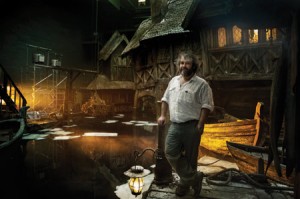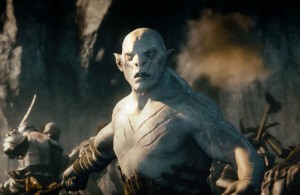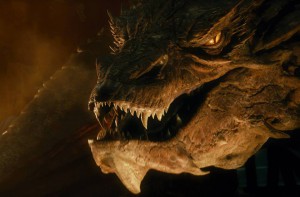
Peter of Many Colours? Jackson Finally Leaves the Path of Wisdom
A review of The Hobbit: The Desolation of Smaug by Timothy R. Furnish, PhD.
Those who have read The Lord of the Rings will recognize the source of my title: the confrontation between Gandalf the Grey and Saruman the White, related by the former at the Council of Elrond.
“I [Gandalf] looked then, and saw that his robes, which had seemed white, were not so, but were woven of all colours, and if he moved they shimmered and changed hue so that the eye was bewildered. ‘I liked white better,’ I said. ‘White!” he sneered. ‘It serves as a beginning. White cloth can be dyed. The white page can be overwritten; and the white light can be broken.’ ‘In which case it is no longer white,’ said I. “And he that breaks a thing to find out what it is has left the path of wisdom.’”
Full disclosure: I am one of those “purists” who thinks Tolkien’s books are indeed the “canon” and, as such, are the true Middle-earth legendarium. However, I also recognize that film is a different medium from print, and that what worked for Tolkien might not always work for Jackson: for example, Aragorn’s striding around the North with a broken sword would be ridiculous in a movie (despite its deep literary significance). Or Tom Bombadil. Yet there is a good reason that the LOTR movies not only made huge profits, but won Academy Awards: they’re based on detailed, indeed scholarly, books that create a convincing Secondary World — which is not true of Star Wars or even my beloved Star Trek (but which is, to a much lesser extent than LOTR, true of Harry Potter).
 Jackson largely stayed true to the spirit and even the letter of LOTR in translating the books to the screen—even acknowledging what Tolkien scholar Tom Shippey (in Another Road to Middle-earth: Jackson’s Movie Trilogy, in Zimbardo and Isaacs, Understanding the Lord of the Rings, 2004) called the “Aragorn Intermezzo” (dragged off the cliff by the warg, only to return to Helm’s Deep), the “Faramir Digression” (deciding to send the ring to Denethor, then relenting) and the “Denethor Downgrade” (making the Steward of Gondor out to be cowardly, mean and stupid — none of which he was). Beyond these, there is of course the most egregious example of Jackson’s infidelity: bringing Elves to Helm’s Deep!
Jackson largely stayed true to the spirit and even the letter of LOTR in translating the books to the screen—even acknowledging what Tolkien scholar Tom Shippey (in Another Road to Middle-earth: Jackson’s Movie Trilogy, in Zimbardo and Isaacs, Understanding the Lord of the Rings, 2004) called the “Aragorn Intermezzo” (dragged off the cliff by the warg, only to return to Helm’s Deep), the “Faramir Digression” (deciding to send the ring to Denethor, then relenting) and the “Denethor Downgrade” (making the Steward of Gondor out to be cowardly, mean and stupid — none of which he was). Beyond these, there is of course the most egregious example of Jackson’s infidelity: bringing Elves to Helm’s Deep!
Still, the LOTR movies did heed the advice that Galadriel gave to the Fellowship in Lorien: “your Quest stands upon the edge of a knife. Stray but a little and it will fail…” In An Unexpected Journey Jackson wandered from the text (both of The Hobbit and the appendices to The Lord of the Rings) but he didn’t get lost. By contrast, The Desolation of Smaug finds PJ somewhere out beyond the Sea of Rhûn, making fans like me wonder if we’ll see Blue Wizards (or worse) show up at The Battle of Five Armies in the final film.
Let us count just the most obvious intermezzos, digressions and downgrades of DOS:
- Gandalf squares off with Saur…er, the Necromancer, despite the former’s explicit statement (at the Council of Elrond) that he only “secretly explored” Dol Guldur and the editorial edict (in Appendix B, “The Third Age,” The Return of the King) that the Istari “were forbidden to match his [Sauron’s] power with power.” (Also: why does the still-recoalescing Sauron wear armor?)
- The whole rather confusing plot line with the Nazgûl entombed by the “Men of the North” seems forced and, frankly, unnecessary. According to the time-lines in Appendix B, the Ringwraiths first appeared in 2251 Second Age, went “into the shadows” when Sauron was defeated and taken prisoner to Númenór, and reappeared in 1300 Third Age — after which the Witch-king of Angmar led a successful campaign to destroy the last surviving remnant kingdom of Arnor, Arthedain. Subsequently, the Witch-king was defeated by the surviving Dúnedain aided by a great army from Gondor and Elves from Lindon—but the victors did not entomb him; he simply “vanished from the North” in 1975 Third Age, only to reappear five years later in Mordor, where he gathered the other Nazgûl. The Hobbit takes place in 2941 Third Age; Sauron reveals himself ten years later, back in Mordor. Why not simply have there be reports of “dark riders” leading or commanding Orcs, hinting that they have returned from the shadows to assist their master? If the purpose of the Nazgûl tombs is to get Gandalf away from Bilbo and the Dwarves, wouldn’t his need to go to Dol Guldur to ascertain the Necromancer’s true identity serve?
- Beorn tells Bilbo, Gandalf, Thorin and company that he is the last of his kind; this, again, contradicts Appendix B, timeline of “The Great Years”, wherein it is said that after the War of the Ring — and the fighting in the North — Thranduil took the northern part of Mirkwood, renamed Greenwood; Celeborn and Galadriel added the southern part thereof to Lorien; and “all the wide forest between was given to Beornings and the Woodmen.” Furthermore, enslavement of Beornings for Orc gladiatorial games is wholly fabricated by Jackson.
- Orcs do not sortie into Esgaroth in either The Hobbit or the Appendices to The Return of the King.
- Thorin and company do not attempt to kill Smaug.
- Tauriel is a wholly-fabricated character. Cute, but completely contrived.
- Kíli does not become infatuated with Tauriel — because she doesn’t exist.
- The Master of Lake-town was actually chosen by election — so he would not denigrate such a system (in The Hobbit the Master says, contra-Bard, that “we have always elected masters from among the old and wise, and have not endured the rule of mere fighting men”).
- Bard is, in The Hobbit, a “grim-voiced and grim-faced” captain of archers, reminiscent of a Clint Eastwood character — not a family man trying to make ends meet via barge smuggling.
 Arguably, not every one of these changes is negative. I do like Tauriel and (reluctantly) fathom why Jackson would want at least one female character in the movie. Having Thorin and his retainer take up arms — or at least kilns — against Smaug was acceptable within the story arc. The critique of democracy that the Master of Esgaroth and his aide Alfrid deliver is funny — whilst inaccurate. Even making Bard less of a recalcitrant loner is defensible.
Arguably, not every one of these changes is negative. I do like Tauriel and (reluctantly) fathom why Jackson would want at least one female character in the movie. Having Thorin and his retainer take up arms — or at least kilns — against Smaug was acceptable within the story arc. The critique of democracy that the Master of Esgaroth and his aide Alfrid deliver is funny — whilst inaccurate. Even making Bard less of a recalcitrant loner is defensible.
The example of Bard does point to the major flaw in both An Unexpected Journey and The Desolation of Smaug: a lack of sympathetic characters, compared to The Lord of the Rings — at least beyond Gandalf and Bilbo.
Beorn summed it up for me: “I don’t like Dwarves — they’re greedy and blind.” PJ’s attempts to make Thorin into a shorter, more brooding Aragorn just don’t work. Frankly, besides Bofur and, at times, Balin, none of the Dwarves are very likable. Dwalin, in particular, turns odious in The Desolation of Smaug — even suggesting they throw Bard overboard and take over his boat. Thranduil is elegant and powerful, but haughty and self-absorbed [Demosthenes’ note: I have seen some describe movie!Thranduil’s attitude as Feanor-esque, which is an interesting thought. Honestly, though, there are probably more parallels with the isolationism and snobbish elitism of Thingol of Doriath as presented in the Silmarillion.] Legolas is — as my two elementary school-age boys put it — a “butthead.” The Master of Lake-town is the Goblin-King with a comb-over and more clothes, while his batman Alfrid is a Dickensian Gríma Wormtongue.
Besides a certain Grey Wizard and a Hobbit, only Bard registers even moderately high on the likability quotient. Yes, perhaps Tauriel and Radagast should be included here. But every time the former is on screen, I see simply dollar signs with pointed ears; and the latter barely showed up in the second movie at all. (Elrond in AUJ was perhaps my favorite character, being much less dour than in The Lord of the Rings; but he’s not in The Desolation of Smaug at all.) Contrast this with the LOTR movies and their multitude of admirable heroes: Gandalf, Frodo, Sam, Aragorn, Theoden, Eómer, Eówyn, Faramir, Merry, Pippin, Treebeard, a humbler Legolas — and Gimli, who even at his most truculent has more personality than all 13 of Bilbo’s companions combined.
Even Boromir, with his recanted perfidy, looks great compared to this bunch of surly Dwarves, treacherous Elves and slimy Lake-towners. Furthermore, the stakes are simply much less here than in LOTR: the restoration of one Dwarf kingdom and dispatch of a dragon vs. a war to prevent the apocalyptic conquest of all Middle-earth by a demonic ruler. And despite the narrative claim by old Bilbo at the beginning of AUJ, Erebor was not “the greatest kingdom of Middle-earth” — that honor belonged, in the Third Age, to Gondor, the heir of Númenór and enemy of Mordor.
There is more than enough material in the appendices of RotK (105 pages) and The Hobbit itself (the only two Tolkien texts to which Tolkien had artistic recourse, legally), for three movies — especially considering that the former consists not of storyline but of editorial narrative, chronologies, time-lines and histories. An utterly convincing, more canonical and equally profitable Hobbit movie could have been made from these sources. Thus, while I would agree with Shippey that, in DOS (and AUJ) as in LOTR, “Jackson has certainly succeeded in conveying much of the more obvious parts of Tolkien’s narrative core,” for me all PJ’s bewildering cinematic wizardry cannot really amend for his overwriting of the Tolkien canon.
Timothy R. Furnish is a PhD in History (Islamic, World and African) and also holds a M.A.R. in Christian theology and history. His book Glorious Warriors And That Which They Defend: War and Politics in Middle-earth’s History should be out from Oloris Publishing in spring 2014.


